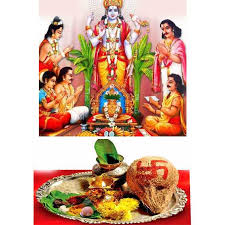Complete Satyanarayan Pooja Kit: Essential Items for Rituals

The Satyanarayan Pooja is a sacred Hindu ritual performed to invoke the blessings of Lord Vishnu, particularly in the form of Satyanarayan, the embodiment of truth. This ritual is commonly conducted to mark special occasions such as birthdays, anniversaries, housewarmings, and other milestones, seeking prosperity, peace, and fulfillment of desires.
To perform the Satyanarayan Pooja with reverence and adherence to tradition, it is essential to have a complete Satyanarayan Pooja kit. This kit comprises specific items that play crucial roles in the ritualistic worship. Understanding each item’s significance and purpose ensures that the pooja is conducted with sincerity and effectiveness.
Essential Items in a Satyanarayan Pooja Kit:
Idol or Picture of Lord Satyanarayan: The central focus of the pooja is Lord Satyanarayan himself. Devotees typically have an idol or a framed picture of Lord Satyanarayan, which is placed in the pooja area or altar. The idol or picture serves as a physical representation of the deity and is worshipped with devotion throughout the ritual.
Murti or Picture of Lord Vishnu: In addition to Lord Satyanarayan, it is customary to have a murti (idol) or picture of Lord Vishnu, as Satyanarayan is considered to be an incarnation of Vishnu. This murti is worshipped alongside Satyanarayan, symbolizing the divine presence and invoking the blessings of Lord Vishnu.
Pooja Thali: The pooja thali (plate) is an essential component of the Satyanarayan Pooja kit. It is used to hold all the items necessary for the ritual, such as roli (vermilion), chawal (rice grains), flowers, incense sticks, aarti diya (lamp), and prasad (offerings). The thali is usually made of metal, such as stainless steel, brass, or silver, and is adorned with decorative elements.
Kalash: A kalash (pot) filled with water and decorated with mango leaves and a coconut is placed on the pooja thali. The kalash symbolizes abundance and purity, and it represents the divine presence during the pooja. The water in the kalash is sanctified and used for various rituals throughout the pooja.
Coconut: A whole coconut is an integral part of the Satyanarayan Pooja kit. It is offered to the deity as a symbol of purity, prosperity, and completeness. The coconut is often placed on the kalash or separately on the pooja thali during different stages of the pooja.
Fruits and Sweets: Offerings of fruits and sweets, such as bananas, apples, oranges, and traditional Indian sweets like peda or laddoo, are presented to the deity as prasad. These offerings signify devotion, gratitude, and the sharing of blessings with others after the pooja concludes.
Camphor and Incense Sticks: Camphor and incense sticks are used during the aarti (ritual of waving light) to create a serene atmosphere and purify the surroundings. The fragrance of incense symbolizes the presence of divinity, while camphor represents the burning away of impurities and ignorance.
Panchamrit: Panchamrit, a sacred mixture of five ingredients—milk, curd, honey, ghee, and sugar—is prepared and offered to Lord Satyanarayan. This mixture symbolizes nourishment, purity, and the sweetness of devotion. After offering to the deity, panchamrit is distributed as prasad to the devotees.
Books or Scriptures: Books containing the Satyanarayan Katha (narrative) and other relevant scriptures are essential components of the pooja kit. The Satyanarayan Katha narrates the divine leelas (stories) of Lord Satyanarayan, emphasizing the importance of truth, righteousness, and devotion in one’s life.
Coins and Dakshina: Offerings of coins and dakshina (monetary donation) are made to the priest conducting the pooja and sometimes to other devotees or Brahmins present. This gesture of generosity and support symbolizes prosperity, gratitude, and the spirit of community.
Holy Threads (Mouli or Kalava): Holy threads, known as mouli or kalava, are tied around the wrist of each participant and sometimes around the kalash or other sacred items. These threads signify protection, blessings, and the bond between the devotee and the deity. They are blessed during the pooja and worn as a symbol of divine grace.
Red Cloth (Chunari): A red cloth or chunari is placed over the idol or picture of Lord Satyanarayan during the pooja. This cloth is considered auspicious and represents devotion, purity, and reverence towards the deity.
Roli (Kumkum) and Chawal (Rice Grains): Roli (vermilion) and chawal (rice grains) are used for applying tilak (religious mark) on the forehead of Lord Satyanarayan and the participants. The tilak signifies blessings, protection, and auspiciousness. Rice grains are also offered during different stages of the pooja as a symbol of abundance and sustenance.
Dhoop and Diya: Dhoop (incense) and diya (lamp) are lit during the pooja to create a sacred ambiance and illuminate the pooja area. The light of the diya symbolizes the presence of divine energy, while the fragrance of dhoop purifies the surroundings and enhances spiritual vibrations.
Conducting the Satyanarayan Pooja:
The Satyanarayan Pooja typically begins with the purification (sankalp) of the devotees and the pooja area. The priest or the head of the household recites prayers and mantras, invoking the blessings of Lord Satyanarayan and seeking divine grace for the fulfillment of wishes and aspirations. The Satyanarayan Katha is then narrated, detailing the divine deeds and virtues of Lord Satyanarayan.
Throughout the pooja, various offerings and rituals are performed with devotion and sincerity. The priest or the person conducting the pooja guides the participants through each step, ensuring that every offering is made according to tradition and with the correct pronunciation of mantras.
After the completion of the pooja rituals, aarti is performed to conclude the ceremony. Devotees sing hymns and wave the aarti diya in a circular motion before the deities, expressing reverence and gratitude. The prasad, including fruits, sweets, and panchamrit, is then distributed among the participants, symbolizing the sharing of blessings and divine grace.
Significance of the Satyanarayan Pooja:
The Satyanarayan Pooja holds significant spiritual and cultural importance for Hindu families. It is believed to bestow blessings of prosperity, success, and overall well-being upon the household and its members. The ritual reinforces faith, devotion, and the values of truthfulness and righteousness, as exemplified by Lord Satyanarayan.
Participating in the Satyanarayan Pooja fosters a sense of unity and harmony within the family and community. It strengthens familial bonds and promotes collective worship, invoking divine blessings for the welfare of all. The pooja also serves as an occasion for expressing gratitude for past blessings and seeking divine guidance for future endeavors.
Conclusion:
A complete Satyanarayan Pooja kit includes a variety of essential items that facilitate the performance of this sacred Hindu ritual with devotion and adherence to tradition. Each item in the kit carries symbolic significance and plays a specific role in invoking the blessings of Lord Satyanarayan and Lord Vishnu.
By understanding the importance of these items and conducting the pooja with sincerity and reverence, devotees can experience spiritual fulfillment and receive divine grace. The Satyanarayan Pooja serves as a means of connecting with the divine, seeking blessings for prosperity and happiness, and upholding the values of truth, righteousness, and devotion in everyday life.

